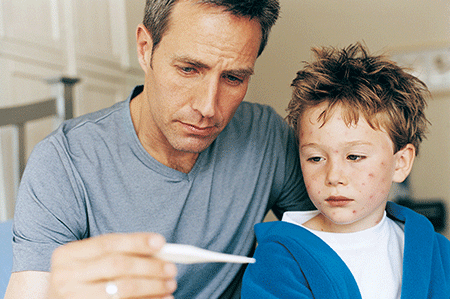How to care for a child with chickenpox
Chickenpox is a highly contagious disease caused by a virus. Although the incidence of chickenpox has declined significantly since the development of the chickenpox vaccine, there are still children who develop chickenpox every year. Fortunately, there is a lot parents can do at home to help ease their children’s symptoms and prevent skin infections.
The most common symptom of chickenpox is a rash that turns into itchy, fluid-filled blisters and then scabs. The rash usually shows up on the face, chest and back first and then spreads to the rest of the body.
Other signs and symptoms of chickenpox may include:
Fever
Tiredness
Loss of appetite
Headache
To help you care for a child with chickenpox, dermatologists recommend the following tips:
Keep your child at home. Since chickenpox is contagious, keep your child at home or limit their exposure to other people until all of their chickenpox blisters have formed scabs and no new blisters develop. It usually takes about a week for the blisters to become scabs.
Soak in colloidal oatmeal baths. Available at your local drugstore and online, colloidal oatmeal will help relieve some of the itch. Add the colloidal oatmeal under the faucet while the tub is filling with lukewarm – not hot – water.
It’s important to use colloidal oatmeal, which is a finely ground powder. Putting oatmeal that you eat into the bathtub won’t relief the itch.Apply calamine lotion; petroleum jelly; or a fragrance-free, anti-itch lotion. Because chickenpox is caused by a virus, don’t use an antibiotic cream or ointment on your child’s skin unless your doctor tells you to use it. An antibiotic cream or ointment could cause an allergic reaction.
Relieve fever. Use a non-aspirin medication like acetaminophen.
To relieve fever, do NOT give a child who has chickenpox:
- Aspirin or products that contain aspirin
- Ibuprofen
When a child has chickenpox, aspirin can cause Reye’s syndrome – a severe disease that affects the liver and brain and can cause death. Ibuprofen has been associated with a life-threatening skin infection.

Relieve itchiness. Consider giving your child an over-the-counter oral (take by mouth) antihistamine made for children. Always follow the directions on the label and use the correct dose. Avoid using an antihistamine that you apply to your child’s skin, as it can trigger an allergic reaction.
Keep your child’s fingernails trimmed short. This will help prevent skin infections caused by scratching the blisters. For young children, put socks or mittens over their hands to prevent scratching. To limit scarring, make sure your child doesn’t pick at his or her chickenpox.
For most healthy children, chickenpox clears on its own without treatment.
If you have a newborn with chickenpox or your child has a weakened immune system, trouble breathing, or develops any blisters that become infected, see your child’s doctor.
Image
Getty Images
Last updated: 8/17/22
 Atopic dermatitis: More FDA-approved treatments
Atopic dermatitis: More FDA-approved treatments
 Biosimilars: 14 FAQs
Biosimilars: 14 FAQs
 How to trim your nails
How to trim your nails
 Relieve uncontrollably itchy skin
Relieve uncontrollably itchy skin
 Fade dark spots
Fade dark spots
 Untreatable razor bumps or acne?
Untreatable razor bumps or acne?
 Tattoo removal
Tattoo removal
 Scar treatment
Scar treatment
 Free materials to help raise skin cancer awareness
Free materials to help raise skin cancer awareness
 Dermatologist-approved lesson plans, activities you can use
Dermatologist-approved lesson plans, activities you can use
 Find a Dermatologist
Find a Dermatologist
 What is a dermatologist?
What is a dermatologist?
